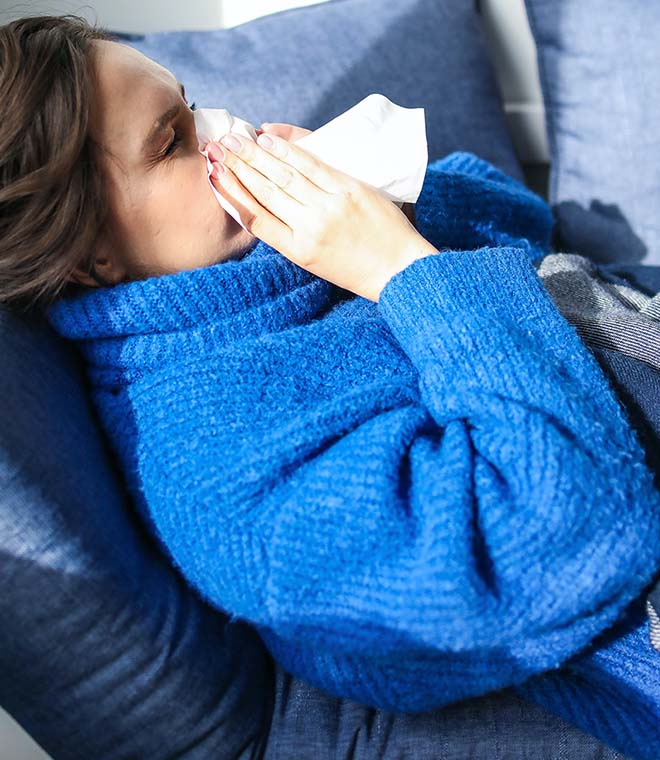Health
How can I get relief from grass allergies?
By Sanjay “Jay” Patel, DO, Allergy & Immunology May 15, 2025 • 8 min
Millions of people suffer from seasonal allergies sparked by the presence of pollen in the air. Grasses are one of the most common sources of allergens. They can cause a variety of symptoms including nasal congestion, sneezing, hives, and itchy, watery eyes. Fortunately, there are things you can do to ease symptoms of grass pollen allergies. Follow these tips to get relief:
1. Understand the cause of grass allergies: Knowing what causes allergies can help you make a more informed decision about treatment options. Allergies occur when your body mistakes a protein called an allergen for a threat. In response, your immune system releases chemicals like histamine. Ordinarily, these chemicals prime your body to fight off germs. However, during an allergic reaction, they trigger the symptoms we associate with allergies. Seasonal allergy symptoms are often referred to as seasonal allergic rhinitis or hay fever.
In the case of grass allergies, pollen is the allergen that sets off the symptom-causing immune response. Pollen is a substance that plants produce for the purpose of reproduction. Grass pollen gets transported by the wind, so it ends up in the air you breathe.
2. Identify what type of grass pollen triggers your symptoms: While there are hundreds of types of grass that grow in the U.S., only some are common sources of allergens. Species that are most likely to trigger allergies include:
- Bahia
- Timothy
- Kentucky blue
- Fescue
- Johnson
- Bermuda
- Orchard
- Rye
- Sweet vernal
Some people have reactions to just one species of grass. For example, they may only have a fescue or timothy grass allergy. Other people may be allergic to several types of grass. In addition, many species of grass are “cross-reactive”. This means your body may confuse them as the same or a similar allergen and produce similar allergy symptoms.
Your healthcare provider can order allergy tests to identify your specific allergies. Once you know what types of grasses may trigger your symptoms, you can learn to identify them by sight and limit your exposure when possible. However, this may be difficult because grass pollens can travel hundreds of miles in the air.
3. Monitor pollen counts: Depending on where you live, pollen season for grasses usually occurs sometime between April and June. During these months, you can use an app, a weather channel or your local TV news to monitor pollen counts. This can be used to predict how much pollen will be in the air on a given day. When the expected pollen count is high, stay indoors as much as possible. If you do need to go outside, consider wearing a face mask.
4. Time yard work accordingly: During pollen season, avoid mowing your lawn and doing other yard work tasks that can stir up pollen. When you can’t leave the work to someone else, consider wearing a pollen mask and gloves while performing these chores. Wash your hands or rinse off in the shower immediately after completing your yard work. Toss your work clothes in the wash.
5. Maintain indoor air quality: Even though grass is outdoors, the quality of the air in your home has an impact on allergy symptoms.
- If your home has air conditioning, run it during hot weather instead of opening windows or using window fans
- Use a dehumidifier to control moisture levels indoors
- Consider putting a free-standing air filtration system with a high-efficiency particulate air (HEPA) filter in your bedroom to remove particulates that can trigger allergies
- Vacuum regularly to remove pollen that gets tracked indoors
- Wipe down your pets’ fur when they return from outdoors to prevent them from transferring grass pollen onto the surfaces in your home
6. Adopt an allergy care hygiene routine: Establish a self-care routine for when you return indoors after spending time outside. Showering or bathing can help remove pollen from your skin. If you don’t have time for a full shower or soak in the tub, wash your face and hands thoroughly and change your clothes.
During allergy season, you can try rinsing your sinuses with saline solution, which is a combination of salt and distilled or sterile water. Doing so can help flush out allergens and thin mucus to alleviate nasal congestion. Saline nasal sprays can also help you breathe more easily throughout allergy season.
7. Use symptom-specific treatments: When you experience isolated symptoms, symptom-specific, over-the-counter allergy medications can help.
- Antihistamine eye drops may help relieve itchy, watery and red eyes
- Allergy cream containing the antihistamine diphenhydramine or hydrocortisone may help calm symptoms of grass rashes
- Nasal corticosteroid sprays like fluticasone propionate and budesonide ease nasal congestion while suppressing the immune system response that triggers allergy symptoms
8. Try over-the-counter oral medicine: Available in pill form, over-the-counter oral antihistamine medications can alleviate multiple symptoms of grass allergies. There are two main kinds:
- First generation: Diphenhydramine and other first-generation antihistamines work quickly and relieve symptoms for a short period, about four to six hours. They often cause drowsiness as a side effect, so it’s important to avoid driving while you’re taking them.
- Second generation: Cetirizine, levocetirizine, fexofenadine, loratadine and other second-generation antihistamines take a little longer to work. However, they may alleviate symptoms for 12 to 24 hours and are less likely to cause drowsiness.
If nasal congestion is also present, a combination decongestant and antihistamine medication may be an option. Your healthcare provider can give you advice about which over-the-counter treatments are appropriate for your needs and health history.
9. Discuss allergy treatment with your healthcare provider: If your grass allergies continue despite self-care and over-the-counter medications, other treatments, like prescription oral medications and nasal sprays, are available. You might also benefit from immunotherapy, which helps your body build up a tolerance to allergens over time. Immunotherapy is an advanced prescribed treatment involving allergy shots or sublingual tablets. Start a conversation with your healthcare provider to explore these and other treatment options so you can enjoy warm weather outdoors without allergy symptoms getting in the way.
Updated by Julie McDaniel, MSN, RN, CRNI, May 2025.
Sources:
- https://www.cdc.gov/climate-health/php/effects/allergens-and-pollen.html
- https://www.hopkinsmedicine.org/health/conditions-and-diseases/seasonal-allergies/allergens-pollen
- https://medlineplus.gov/druginfo/meds/a601044.html
- https://medlineplus.gov/ency/patientinstructions/000549.htm
- https://familydoctor.org/antihistamines-understanding-your-otc-options/
- https://www.aaaai.org/tools-for-the-public/conditions-library/allergies/mowing-down-your-grass-allergies
- https://www.niehs.nih.gov/health/topics/agents/allergens/pollen/index.cfm
- https://www.ncbi.nlm.nih.gov/books/NBK538188/
- https://aafa.org/allergies/types-of-allergies/pollen-allergy/
- https://www.mayoclinic.org/diseases-conditions/hay-fever/in-depth/seasonal-allergies/art-20048343
- https://aafa.org/allergies/types-of-allergies/pollen-allergy/grass-pollen-allergy/
- https://www.aaaai.org/tools-for-the-public/allergy,-asthma-immunology-glossary/cross-reactivity-defined
- https://www.mayoclinic.org/drugs-supplements/hydrocortisone-topical-application-route/side-effects/drg-20073814



